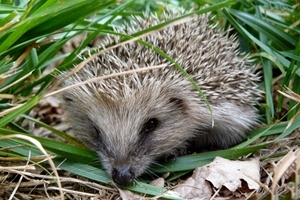Hedgehog
 Hedgehogs are one of the nation’s favourite animals, beloved by gardeners and instantly recognised by their defensive coat of thousands of tough keratin spines – a feature that inspires nicknames such as ‘urchin’ and ‘furze-pig’. There are 17 species in the world, varying from the desert hedgehog to the four-toed and bare-bellied. Ours is the European variety, Erinaceus europaeus.
Hedgehogs are one of the nation’s favourite animals, beloved by gardeners and instantly recognised by their defensive coat of thousands of tough keratin spines – a feature that inspires nicknames such as ‘urchin’ and ‘furze-pig’. There are 17 species in the world, varying from the desert hedgehog to the four-toed and bare-bellied. Ours is the European variety, Erinaceus europaeus.
If you think about it, it’s rather obvious why we call them hedgehogs – they ‘hog’ the edges of linear features like walls and hedgerows to get around, and hedges are a great source of food and shelter. They also resemble pigs in the way they snuffle around in undergrowth and soil to find food.
Famous for their garden pest control, they can guzzle up to 200g of invertebrates per night. Aside from their favoured worms, slugs and beetles, they will also take carrion, amphibians, baby rodents, bird chicks and eggs, all of which can be found in the habitat they are most commonly found in nowadays: gardens, parkland and woodland.
The hedgehog has a famous habit of rolling up in a defensive ball, and its tough back muscles are specially configured to contort and contract – rather like drawing purse strings. When they tense the shallow muscles under the skin, their spines protrude in all directions, which cushions their fall if they lose their footing and flummoxes most predators – except badgers, which have claws strong enough to unfurl them. The follicle muscles supporting each individual spine are so strong that it is possible to pick up a hedgehog by a single spine, but this is equivalently painful to suspending you by a handful of your hair!
If you look closely, you can see that they actually have quite long legs, which enable them to get a scuttle on if they need to. And if you look closer still, you’ll see a little tail – perhaps it was gradually lost during their evolution because they couldn’t tuck it into their armour neatly?
Because of their nocturnal nature, few people encounter a living hedgehog, but if you know they’re in your village or town and you put out some food, hog-watching is quite easy. They have relatively poor eyesight, so if you stand quietly with a soft light, they can come right up to you, especially if they are occupied with foraging or self-anointing (a puzzling habit of coating themselves with foamy saliva). I have hedgehogs in my garden, and luckily for me they have unsophisticated taste: basic Morrisons cat biscuits, fed in a little boxed feeding station at the other end of my garden. A feasting hedgehog makes such a racket that from over 25 yards away I can hear whether or not they’re present. The munching is akin to a dog inhaling a bag of prawn crackers.
They’re also pretty noisy when it comes to mating. Males and females (boars and sows) circle one another, huffing and puffing and snorting as loud as any human. Competing boars can get into vicious fights, whereby they seize one another with their teeth, shaking, chasing and headbutting each other. Sows are not faithful to any one particular mate and they can have up to three litters of hoglets in a summer. Hedgehogs can travel vast distances on their foraging and mating rounds (1-2km in a night) visiting up to 30 gardens through a network of holes and gaps in property boundaries.
Hedgehogs haven’t always been revered for their pest control abilities and inherent cuteness – they were once on the dinner table! Culinary historians have found that roast hedgehog is one of the oldest recipes in Britain, pre-dating Roman times along with other curious dishes like nettle pudding and pottage. Until the mid-20th Century, gypsies in France and England would coat them in clay and bake them in the ashes of a fire. In theory, upon cooling the clay breaks away taking the spines with it, and the tender ‘pork-like’ meat inside is revealed!
The European hedgehog has been introduced by adoring Brits to various UK islands, but also much further afield. British settlers took them to New Zealand in the late 19th Century in the hope they would remind them of home, but by the 1920s their population had exploded and they were declared a pest with severe impacts on native snails, beetles, skinks and ground-nesting birds. Authorities paid ‘a shilling a snout’ to incentivise their removal, but they have now populated every colonisable inch of the country and New Zealand is thought to have more hedgehogs than the UK. Perhaps it’s time to send them our clay-baking recipe!
Alas, one nation’s pest is another’s treasure, and our UK native population is in serious decline. However cleverly engineered, their prickly exterior doesn’t protect them from threats such as nesting/foraging habitat loss, machinery and vehicles, bonfires and pesticides. The number of hedgehogs left in the UK is hard to estimate because data is based on roadkill and incidental records from garden-watch campaigns, but it’s thought to be 1 million. According to the British Hedgehog Preservation Society, we have lost over half of rural hedgehogs and a third from towns and cities in the last decade. But thankfully, there’s advice out there from the BHPS, RSPCA and Up Gardener to help spread the word and improve resources in gardens and on farms, to give our spiny friends the best chance in these challenging times.
Jess Brooks
Advisory

Get Peter Thompson's essential 26-page book, featuring beautiful photography and detailed profiles of Britain's wildlife, for just £1.99.
Find out more >